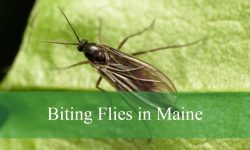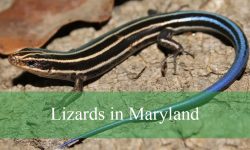If you’re curious about the diverse types of spiders in Montana, you’re in the right place. Montana’s varied landscapes—from forests and grasslands to wetlands and urban areas—provide an ideal habitat for many fascinating spider species. Whether you’re a nature enthusiast, a beginner arachnologist, or just someone wanting to know more about the spiders in Montana, this guide will help you identify and appreciate these incredible eight-legged creatures.
Spiders play an important role in Montana’s ecosystems by controlling insect populations and maintaining ecological balance. With over 40 common species found across the state, the variety of spiders in Montana is both surprising and impressive. Each species has unique characteristics, behaviors, and habitats, making the study of Montana’s spiders a rewarding experience for anyone interested in wildlife.
In this article, we’ll explore 40 different types of spiders in Montana, complete with detailed descriptions and pictures to help with identification. From the bold jumping spiders to the elusive black widows, you’ll learn how to recognize these spiders and understand their role in Montana’s natural world. Get ready to discover the fascinating diversity of Montana’s spider population!
Different Types of Spiders in Montana
Bold Jumping Spider (Phidippus audax)

The Bold Jumping Spider is one of the most commonly seen jumping spiders in Montana. It has a compact, fuzzy body, typically black with striking white or orange markings on the abdomen. The most distinctive feature is its iridescent green or blue chelicerae (fangs), which shimmer in the light and add to its bold appearance.
This spider is known for its exceptional vision and agile movements. Instead of building webs to catch prey, it actively stalks and pounces on insects with precise leaps. It uses silk mainly for anchoring itself and constructing small retreat shelters, often found under rocks, leaves, or within corners of structures.
In Montana, Bold Jumping Spiders thrive in a wide range of habitats including grasslands, gardens, forest edges, and even the interiors of homes and sheds. Their adaptability and curious nature make them a common sight throughout spring, summer, and early fall across much of the state.
Common House Spider (Parasteatoda tepidariorum)
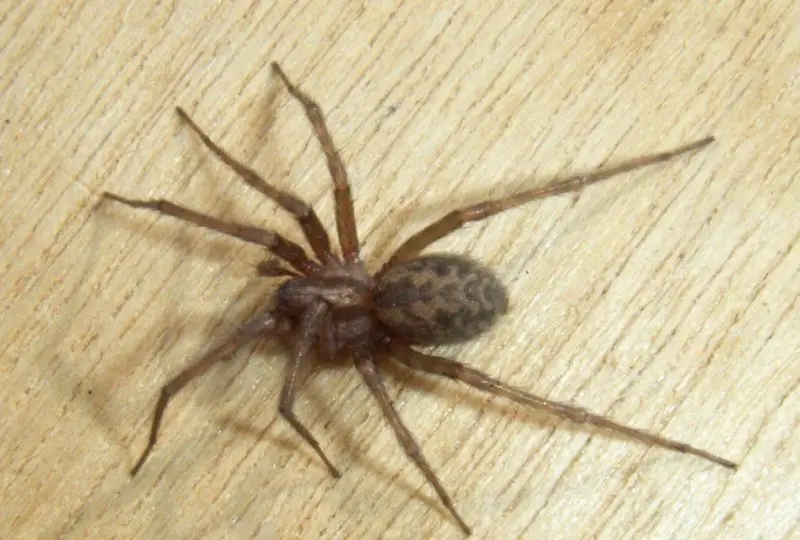
The Common House Spider is a small, unassuming cobweb weaver frequently found in human dwellings throughout Montana. It has a rounded, bulbous abdomen with mottled brown or gray patterns and relatively long, slender legs. Females are typically larger than males and more frequently encountered.
These spiders construct irregular, messy webs in quiet corners, basements, attics, and garages. They rely on their webs to catch flying or crawling insects, remaining motionless for long periods while waiting for vibrations. Although they might appear intimidating, they are harmless to humans and often serve as natural pest controllers indoors.
In Montana, the Common House Spider is widespread, especially in urban and suburban environments. They are most visible during late summer and early fall when they reach maturity. Their preference for undisturbed indoor spaces means they are often year-round residents in heated buildings.
Grass Spider (Agelenopsis spp.)
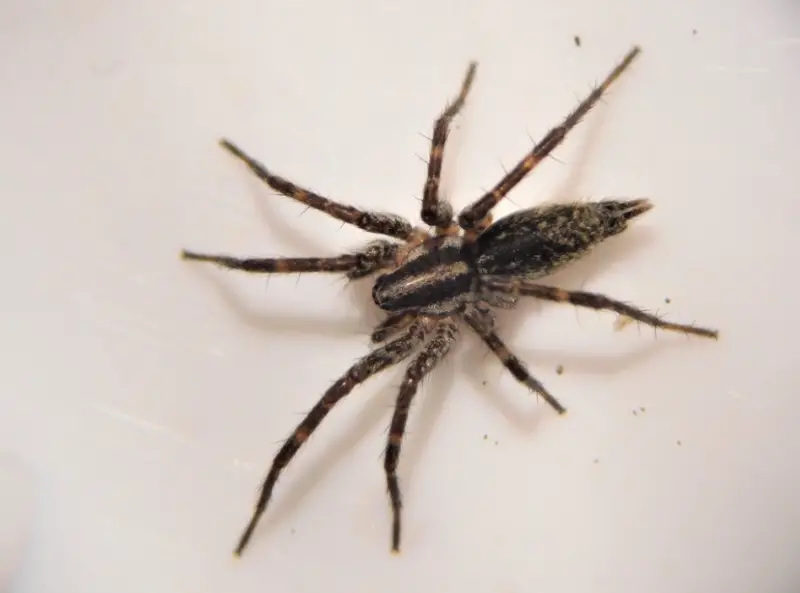
Grass Spiders are known for their characteristic funnel-shaped webs, which are often seen stretched across grasses, shrubs, or corners of buildings. These spiders have elongated bodies with distinct longitudinal striping on the cephalothorax and a more subtle pattern on the abdomen. Their legs are long and spiny, aiding their rapid movement.
Unlike orb-weavers, Grass Spiders do not rely on sticky silk to ensnare prey. Instead, they sense vibrations from the web and sprint out of their funnel hideout to subdue insects. They are shy and non-aggressive, retreating quickly when disturbed.
In Montana, Grass Spiders are abundant in meadows, lawns, parks, and open woodland areas. Their webs become especially noticeable in the early mornings of late summer, when dew outlines the funnel structures. Though common outdoors, they rarely enter homes.
Wolf Spider (Hogna spp.)
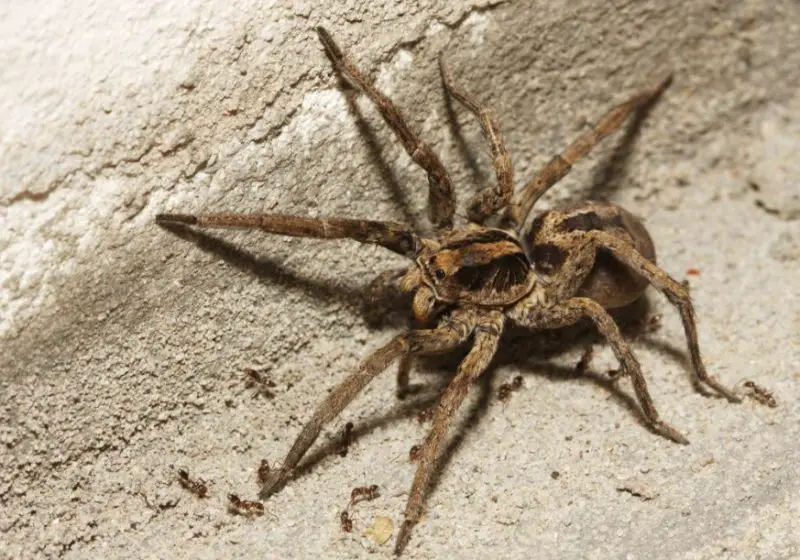
Wolf Spiders are large, ground-dwelling hunters with excellent eyesight and robust bodies. Most individuals have earthy brown or gray coloration with darker stripes or blotches and hairy legs. Their eyes shine under flashlight beams at night, making them easily identifiable after dark.
They do not build webs to catch prey but instead roam actively in search of insects and other arthropods. Female Wolf Spiders are notable for carrying their egg sacs attached to their spinnerets, and later, carrying the hatchlings on their backs—a rare behavior among spiders.
These spiders are widely distributed across Montana, from grasslands and pine forests to riverbanks and rocky slopes. They are commonly seen in late summer and early fall, especially in areas with dense vegetation or loose soil where they can burrow or find cover.
Long-bodied Cellar Spider (Pholcus phalangioides)
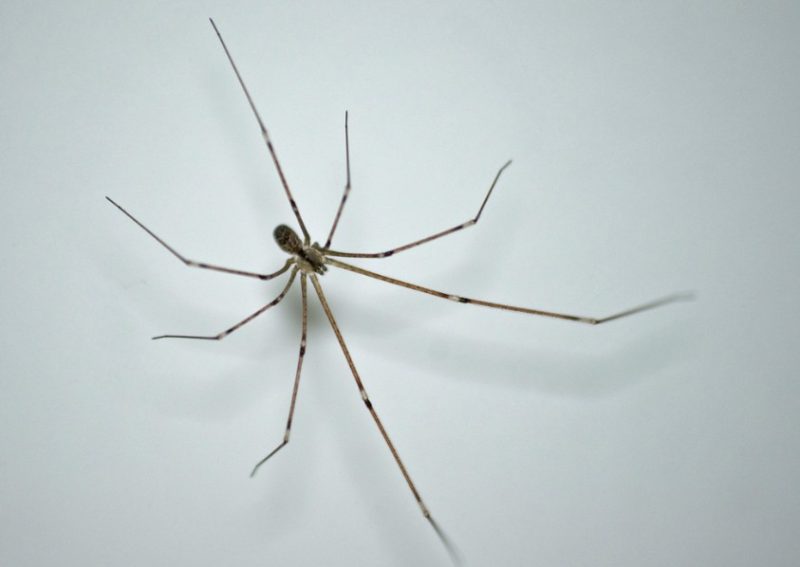
The Long-bodied Cellar Spider, often called a “daddy longlegs spider,” is easily recognized by its extremely long, delicate legs and small, cylindrical body. It is pale tan or gray and often confused with harvestmen, although they are a distinct type of arachnid.
This species builds loose, irregular webs in dark, sheltered places such as basements, crawl spaces, and barns. When threatened, it vibrates rapidly in its web, a behavior thought to confuse predators. It is known to prey on other spiders, including more dangerous ones like the black widow.
In Montana, Long-bodied Cellar Spiders are found mainly in human structures, particularly older buildings and damp cellars. While they are not native to North America, they have established themselves well and are now a familiar sight throughout much of the state.
Cross Orb Weaver (Araneus diadematus)

The Cross Orb Weaver is a visually striking spider, recognized by the white cross-shaped markings on its abdomen. Its color ranges from pale yellow to dark reddish-brown, and it has a rounded, bulky body. This species is a member of the orb-weaver family, known for spinning large, circular webs.
These spiders are most active during late summer and early fall, often seen sitting in the center of their webs, which are typically built between branches, fences, or even on the sides of buildings. At night, they may retreat to a hidden spot nearby but still remain connected to the web via a signal thread. They are not aggressive and will drop from the web or flee when disturbed.
In Montana, Cross Orb Weavers are widespread and common in gardens, wooded areas, and fields. Their webs can often be found glistening with morning dew, making them particularly noticeable. Despite their fearsome appearance, they are harmless and beneficial for controlling insect populations.
Barn Spider (Araneus cavaticus)

The Barn Spider is a plump, robust orb-weaver commonly associated with rural structures like barns, sheds, and porches. It typically has a brown or grayish body with darker patterning on the abdomen and short, thick legs with banded coloring. Females are noticeably larger than males.
Like other orb-weavers, Barn Spiders construct large circular webs that are rebuilt nightly. During the day, they hide near the edges of the web or in a nearby crevice. They feed on flying insects that become trapped in the web, quickly immobilizing their prey with silk before consuming it.
This species is native to North America and is widely distributed in Montana, especially in agricultural settings or semi-open areas near human dwellings. Their presence increases during late summer and fall, and they are a familiar sight in farm communities throughout the state.
Yellow Sac Spider (Cheiracanthium spp.)
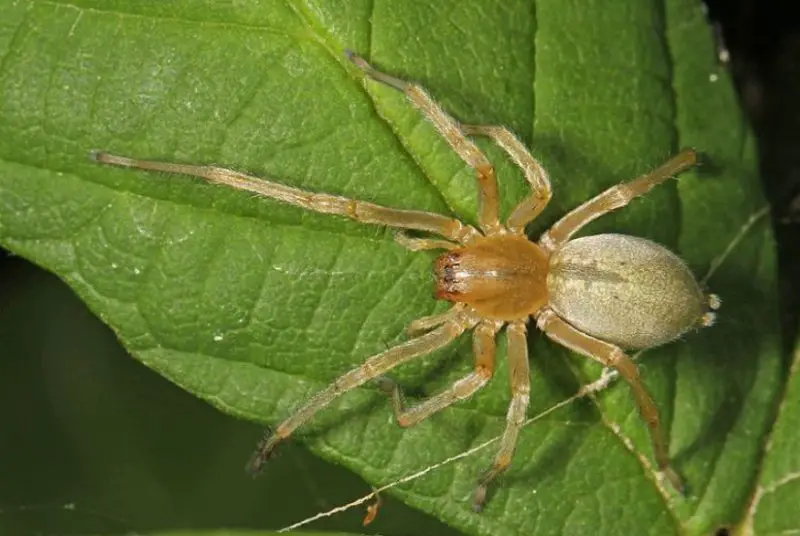
Yellow Sac Spiders are small, fast-moving hunters with pale yellow or light green bodies. They have a slightly elongated abdomen and long legs, often giving them a delicate appearance. Unlike orb-weavers, they do not build traditional webs but instead create small silken sacs for resting.
These spiders are nocturnal and actively hunt insects at night. During the day, they rest inside their silk retreats, which are commonly found in corners of ceilings, under leaves, or behind wall trim. They are known for their tendency to bite humans, particularly if trapped in clothing or bedding, although their bites are usually mild and heal quickly.
In Montana, Yellow Sac Spiders can be found both indoors and outdoors. They are common in homes, garages, gardens, and shrubs, especially during the warmer months. Their adaptability to indoor environments makes them one of the more frequently encountered household spiders in the state.
Crab Spider (Misumena vatia)
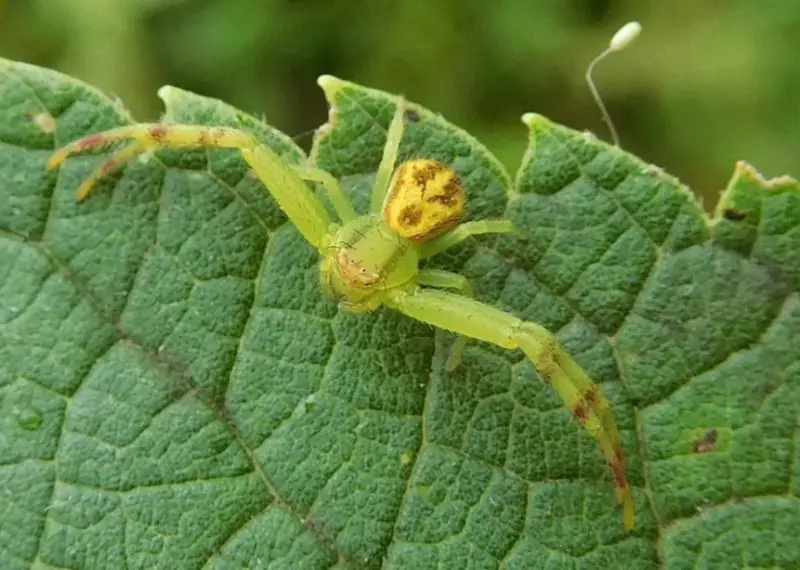
The Crab Spider is named for its crab-like appearance and ability to walk sideways. It has a broad, flattened body and can vary in color from white to yellow, depending on the flower it inhabits—this camouflage helps it ambush pollinators. Females are significantly larger and more colorful than males.
These spiders do not spin webs to capture prey. Instead, they sit motionless on flower petals, waiting to grab unsuspecting bees, flies, or butterflies with their powerful front legs. Their venom quickly immobilizes prey much larger than themselves, making them efficient predators despite their size.
In Montana, Crab Spiders are commonly found in wildflower meadows, gardens, and open grassy areas. They are most visible in mid to late summer when wildflowers are in full bloom. Their unique hunting style and ability to change color slightly make them fascinating creatures to observe.
Running Crab Spider (Philodromus spp.)
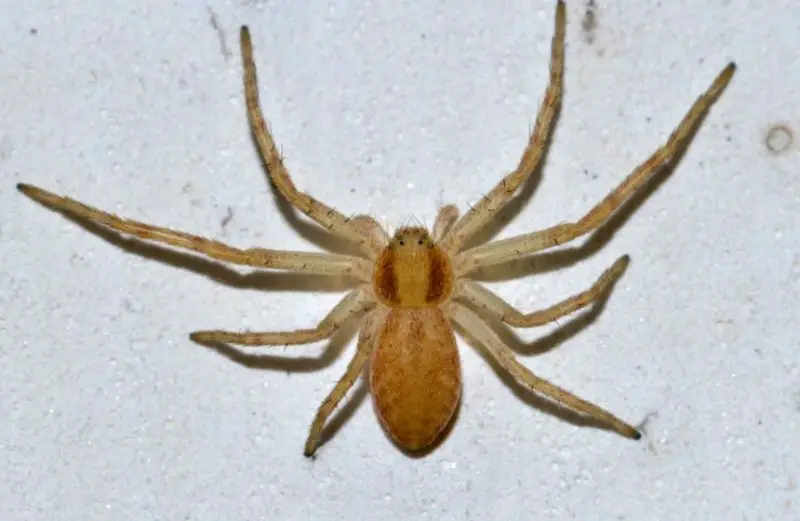
Running Crab Spiders are agile hunters that resemble crab spiders but are generally flatter and have longer, thinner legs. Their colors range from gray to light brown, often with faint markings that help them blend into tree bark or leaf litter. Unlike many spiders, they are not web-dependent.
These spiders are fast and rely on their speed and stealth to catch prey. They are often seen darting across walls, fences, and tree trunks. They create small silk retreats but do not build capture webs. Their behavior is similar to that of wolf spiders, though they are less robust and more arboreal.
In Montana, Running Crab Spiders are found in a variety of habitats, including forests, shrublands, and even gardens. They are especially active in warm weather and can often be seen on foliage, waiting for insects to approach. Their speed and elusive nature make them less commonly noticed despite being widespread.
Orb Weaver (Araneus spp.)

Other species of Orb Weavers in the Araneus genus are quite diverse in appearance but share the common trait of creating large, circular webs. Their bodies are often rounded and may feature intricate patterns or bold colors such as browns, oranges, and even greens. Most individuals have spiny or hairy legs that are well-suited for web-spinning.
These spiders are typically nocturnal and construct their webs in the evening, tearing them down in the morning to conserve resources. They patiently wait at the center or edge of their webs for prey to become ensnared. When an insect lands on the web, the spider quickly subdues it with a bite and wraps it in silk for later consumption.
In Montana, various Araneus species are found in woodlands, meadows, gardens, and around buildings. Their activity peaks in late summer and early fall. Though their webs are often visible and impressive, the spiders themselves are shy and generally avoid confrontation, posing no danger to humans.
False Widow (Steatoda spp.)

False Widows are medium-sized cobweb spiders that resemble the more infamous black widow but are much less dangerous. Their shiny, globe-shaped abdomens are often dark brown or black with faint markings, sometimes featuring a creamy or reddish tint. They have long, slender legs and build messy, irregular webs.
These spiders prefer to remain hidden in their webs and are not aggressive. When prey becomes tangled, they deliver a venomous bite to immobilize it, then wrap it in silk. While their bite can cause minor irritation in sensitive individuals, it is not medically significant like that of the true black widow.
In Montana, Steatoda species can be found in sheltered environments such as basements, woodpiles, barns, and garages. They are year-round residents in warmer indoor environments and are most active from late spring through fall. Due to their resemblance to dangerous spiders, they are often misidentified and unnecessarily feared.
Funnel Weaver (Tegenaria spp.)
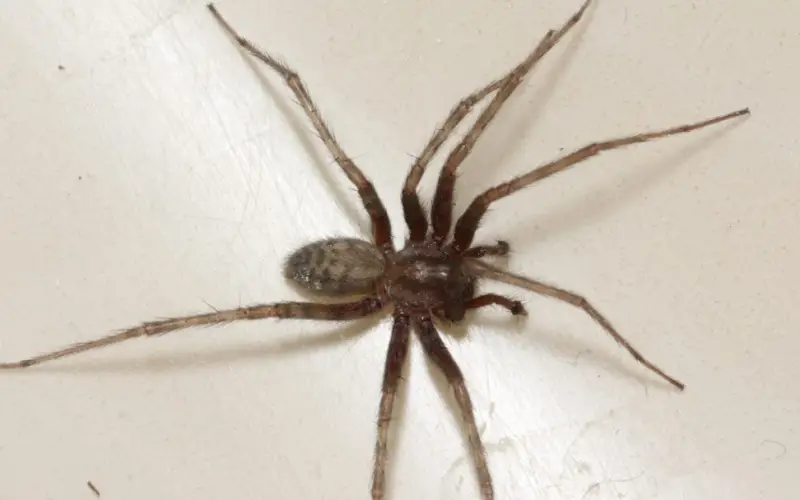
Funnel Weavers are known for their distinctive horizontal sheet webs with a tubular retreat at one end. Their bodies are elongated, and they often display striped or banded patterns across their legs and cephalothorax. They range in color from light brown to dark gray and are covered in fine hairs.
These spiders wait inside the funnel portion of their web for vibrations indicating prey has landed on the surface. They rush out quickly, seize the intruder, and pull it back into the funnel to feed. They are fast and elusive but non-aggressive unless provoked.
In Montana, Funnel Weavers are widespread in grassy fields, under logs, and in low vegetation. Some species may also inhabit human structures like sheds and barns. Their webs become most visible in the fall mornings when dew outlines their silk sheets, especially in meadows and along fences.
Sheetweb Weaver (Linyphiidae spp.)
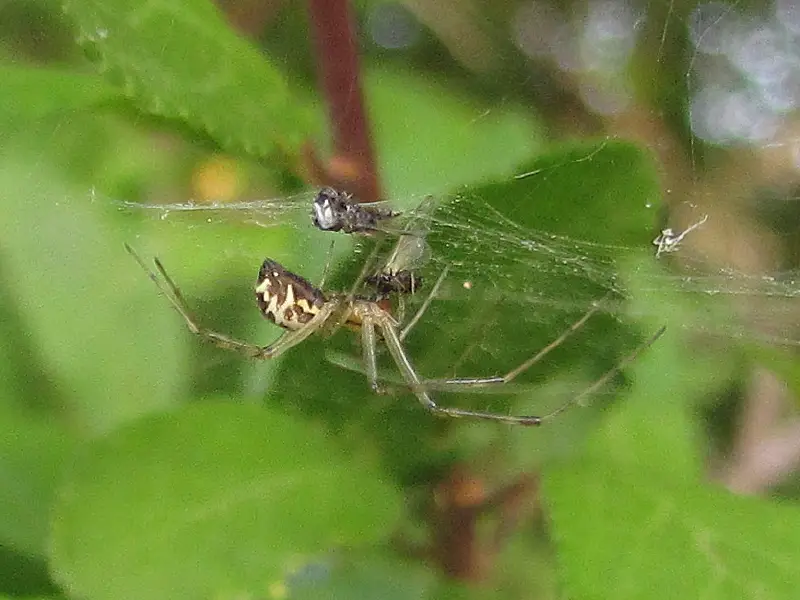
Sheetweb Weavers are small, delicate spiders that belong to the large and diverse Linyphiidae family. They typically have tiny bodies, often no more than a few millimeters long, and range in color from tan to dark brown or gray. Their legs are thin and relatively long in proportion to their bodies.
They build flat, dense sheets of webbing close to the ground or in low vegetation. Above the sheet, a tangle of silk lines helps knock flying insects into the web below, where the spider captures them from underneath. Due to their size and hidden lifestyle, they are not easily noticed by casual observers.
In Montana, Sheetweb Weavers are very common in grassy meadows, forests, and agricultural fields. They play a critical ecological role in controlling populations of small insects. While easily overlooked, their web structures often become apparent during dewy mornings in the fall.
Zebra Jumping Spider (Salticus scenicus)

The Zebra Jumping Spider is a small, active spider named for its black-and-white striped pattern that resembles a zebra. It has a compact body and short legs, with large, forward-facing eyes that provide excellent vision. This gives them a curious and almost animated appearance.
Rather than spinning webs to trap prey, Zebra Jumping Spiders rely on their agility and eyesight to stalk and leap onto insects. They can jump many times their body length and often explore walls, windowsills, and rocks in search of food. Males are known for their rhythmic courtship dances, which they perform to impress females.
In Montana, they are found in sunny, open areas such as rocky outcrops, garden beds, fences, and buildings. They are most active during the warmer months and are often seen during the day. Their bold behavior and unique appearance make them a favorite among those interested in observing spiders up close.
Six-spotted Fishing Spider (Dolomedes triton)
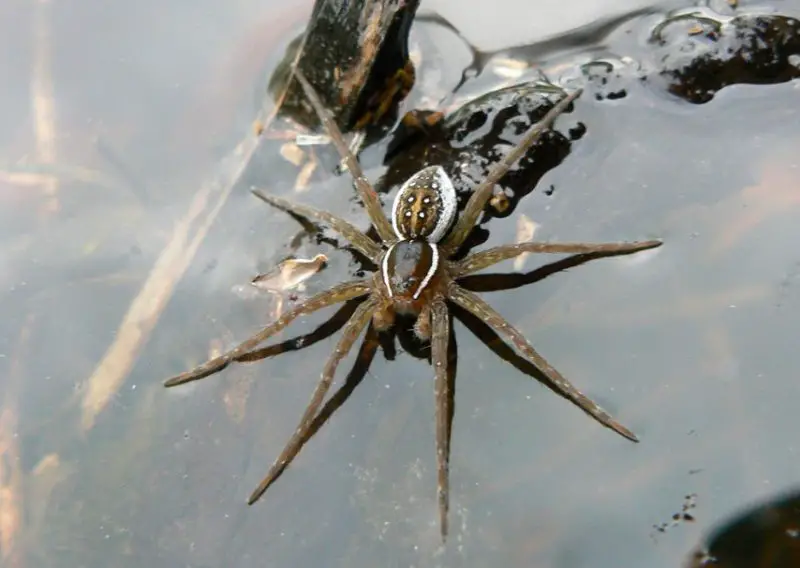
The Six-spotted Fishing Spider is a large and impressive spider known for its semi-aquatic habits. It has a gray to brown body with pale stripes running along the sides of its cephalothorax and abdomen. The underside of its cephalothorax often shows six distinct black spots, which give the species its name.
These spiders do not spin webs to catch prey. Instead, they hunt actively by skimming across the surface of water or diving beneath it. They are capable of capturing insects, tadpoles, and even small fish, relying on their strong legs and quick reflexes. Their large eyes also provide excellent vision, aiding in their predatory lifestyle.
In Montana, Six-spotted Fishing Spiders are typically found near ponds, marshes, lakes, and slow-moving streams. They are most active during the warmer months and are often seen resting on vegetation near the water’s edge. Though their size can be intimidating, they are not dangerous to humans and avoid confrontation.
Nursery Web Spider (Pisaurina mira)
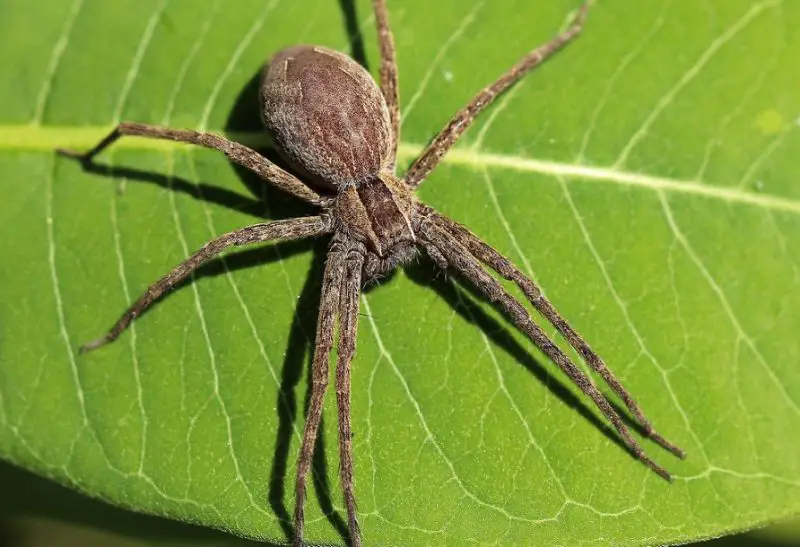
The Nursery Web Spider closely resembles a wolf spider but has slimmer legs and a lighter brown or tan coloration with a distinct dark stripe running down the center of its back. It has long legs and a smooth, flattened body, making it well-suited for fast movement and ambush-style hunting.
This spider is named for its maternal behavior. After laying eggs, the female carries the egg sac in her jaws and later constructs a protective nursery web for her spiderlings, where she guards them until they disperse. Like wolf spiders, nursery web spiders do not build prey-catching webs and rely on speed and stealth.
In Montana, Pisaurina mira is commonly found in fields, tall grasses, and shrubs, especially near wooded or moist environments. They are more active in late spring and early summer and often hunt at night. Their nurturing care of their young sets them apart from many other spider species.
Ant Mimic Spider (Castianeira spp.)
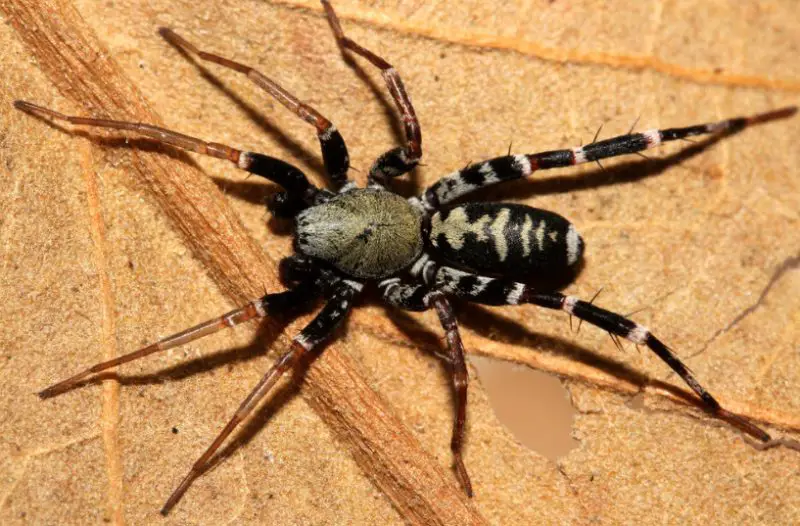
Ant Mimic Spiders are slender, agile spiders that imitate the appearance and behavior of ants. Their bodies are typically dark with metallic or reddish markings, and their front legs are often held up to mimic antennae. This mimicry helps protect them from predators that avoid ants.
They are active hunters and do not use webs for capturing prey. Instead, they stalk insects on the ground or vegetation, relying on speed and surprise. Their mimicry also helps them get close to actual ants or other insects without raising alarm. Males and females can differ slightly in coloration and size.
In Montana, Castianeira species are found in open habitats such as fields, gardens, and forest edges. They are not commonly seen due to their small size and fast movement, but they are fairly widespread. Their unique ant-like behavior makes them a fascinating example of adaptive evolution.
Cobweb Spider (Theridiidae spp.)
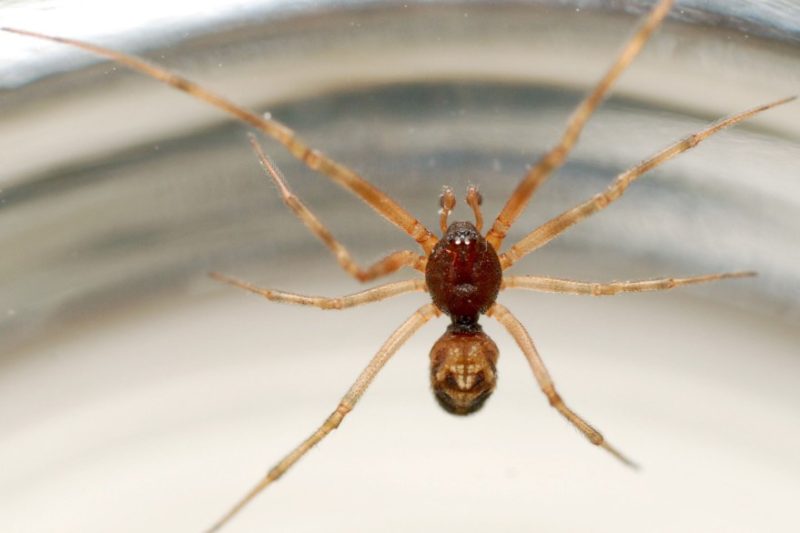
Cobweb Spiders, members of the Theridiidae family, are small spiders with round abdomens and long, delicate legs. Their coloration varies widely among species, from light tan to dark brown or black, often with mottled or marbled patterns. They are best known for building messy, irregular webs in sheltered locations.
These spiders hang upside-down in their webs and wait for prey to stumble into the sticky strands. Once captured, the prey is quickly wrapped in silk and immobilized. Many species in this family, such as the false widows, live in close proximity to humans and thrive in both natural and artificial structures.
In Montana, cobweb spiders are found in sheds, basements, garages, under decks, and also in vegetation. They are active throughout the year, especially indoors. While their webs may appear untidy, they are highly effective at catching flies, mosquitoes, and other nuisance insects.
Ground Spider (Gnaphosidae spp.)
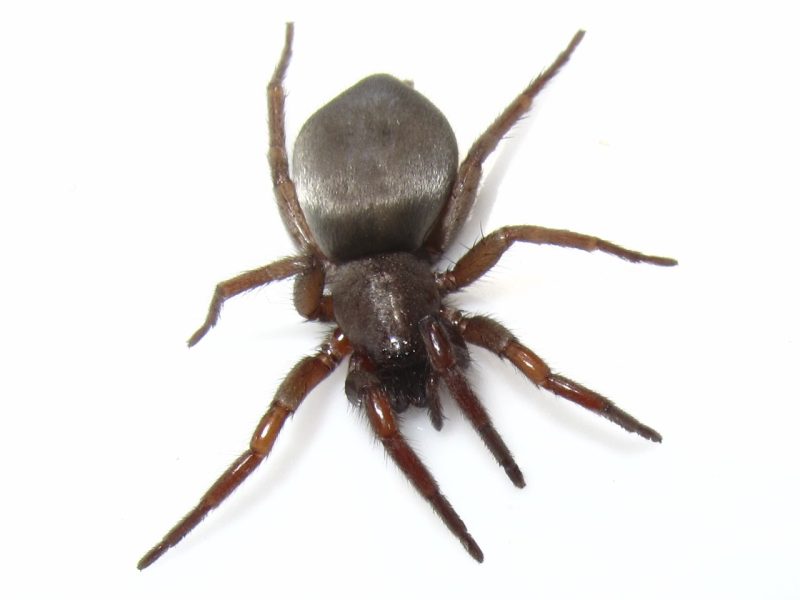
Ground Spiders belong to the Gnaphosidae family and are generally small to medium-sized with flat bodies and short, robust legs. They are typically brown, gray, or black, with subtle striping or speckled patterns. Their spinnerets are often visible, giving them a distinctive rear-end appearance.
These spiders are nocturnal hunters that do not spin webs to catch prey. Instead, they roam over the ground at night searching for insects and other arthropods. During the day, they hide under rocks, leaf litter, or loose bark in silken retreats. They are quick-moving and elusive.
In Montana, Ground Spiders are found in forests, grasslands, and suburban yards. They are common but rarely seen due to their secretive habits. Their preference for remaining close to the ground and under cover makes them important nocturnal predators in the local ecosystem.
Trashline Orbweaver (Cyclosa turbinata)
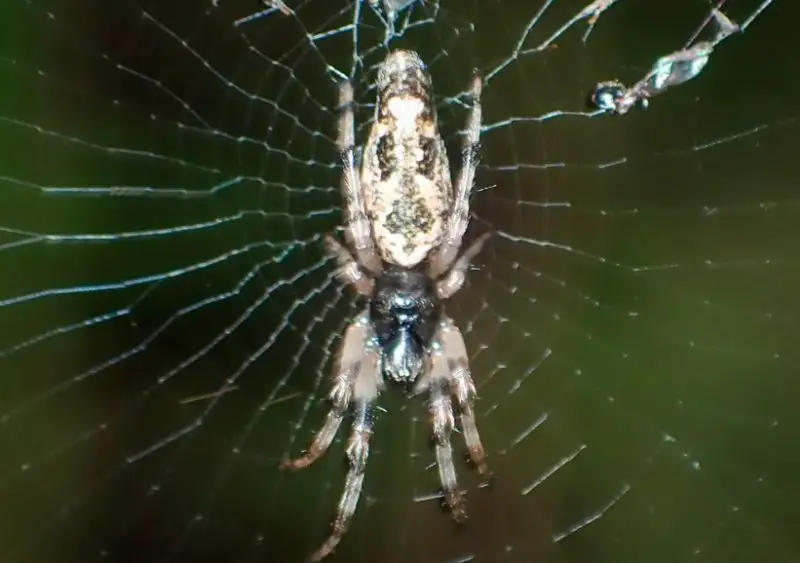
The Trashline Orbweaver is a small and clever spider known for decorating its web with debris, including insect remains and silk-wrapped items, which form a “trashline.” This line runs vertically through the web and often hides the spider in plain sight. The spider itself is compact, brown or gray, with a humped abdomen and subtle markings.
This species constructs classic orb-shaped webs, usually in low vegetation, shrubs, or even man-made structures. During the day, the spider aligns itself along the trashline to blend in, relying on camouflage to avoid predators. At night, it becomes more active, repairing the web and hunting for small flying insects.
In Montana, Cyclosa turbinata can be found in gardens, woodland edges, and grassy areas. It is not as conspicuous as some other orbweavers due to its size and secretive behavior. However, its uniquely decorated web makes it easier to spot for those who look closely.
Habronattus americanus
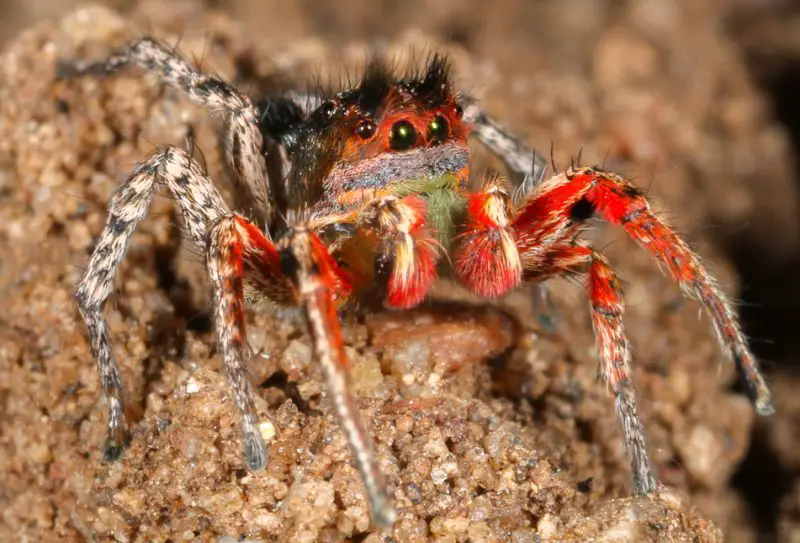
Habronattus americanus is a vibrant member of the jumping spider family, known for its bold colors and elaborate courtship dances. Males often display metallic green or red markings on the face and legs, while females are typically more muted in appearance. These spiders have compact bodies, strong front legs, and excellent vision from their large forward-facing eyes.
Jumping spiders do not spin webs to capture prey. Instead, they actively stalk and pounce on insects with remarkable agility. Males of Habronattus americanus perform complex dances to attract females, showcasing their colorful faces and rhythmic leg movements.
This species is found in sunny, open habitats across Montana, including meadows, rock piles, and open fields. They are most often seen in the warmer months, hopping along ground surfaces or low plants. Their energetic movements and curious nature make them a favorite among spider enthusiasts.
Pelegrina proterva

Pelegrina proterva is a small but distinctive jumping spider commonly found throughout North America, including Montana. Its body is compact and dark brown, often with pale stripes or speckled patterns on the abdomen and cephalothorax. The spider’s large, prominent eyes give it excellent depth perception for jumping.
Like other members of the Salticidae family, this species hunts by ambush, using short bursts of speed and precision jumps to capture prey. It does not spin webs to trap insects, instead relying on stealth and agility. The spider’s short, stocky legs are adapted for leaping and quick movements.
In Montana, Pelegrina proterva is often found in grassy fields, gardens, and among leaf litter. It tends to stay low to the ground and is most active during the day. Although it’s small and easily overlooked, its behavior and visual acuity are highly advanced for its size.
Lynx Spider (Oxyopes spp.)
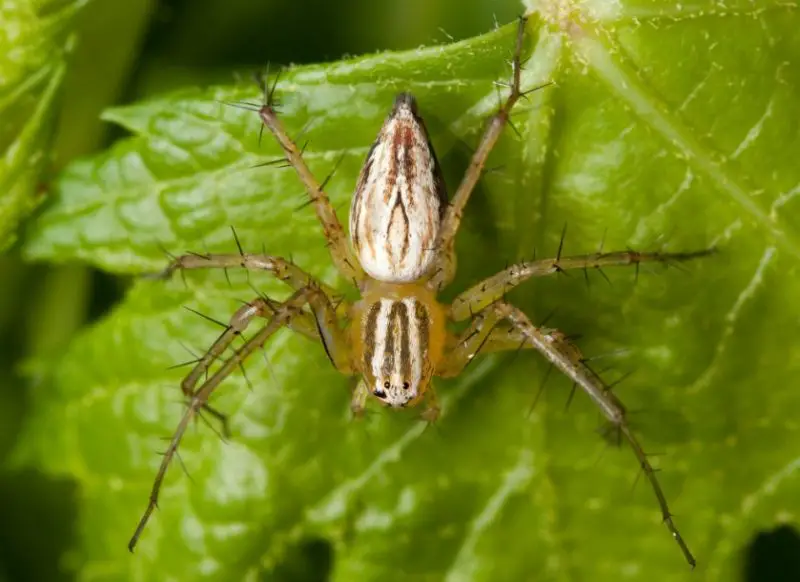
Lynx Spiders are easily recognized by their spiny legs, tapered bodies, and cat-like agility—traits that give them their name. They are usually green or yellowish with longitudinal stripes or spots on the abdomen, and their large eyes form a hexagonal arrangement on the front of the face.
These spiders are fast, active hunters that do not build webs to catch prey. Instead, they rely on their keen eyesight and quick reflexes to chase down and capture insects. They often perch on flowers and foliage, lying in wait for pollinators like bees or flies to approach.
In Montana, Oxyopes species are frequently found in gardens, prairies, and meadowlands during the summer months. Their preference for sunny, open habitats makes them visible to observant hikers and gardeners. Though intimidating in appearance, they are harmless to humans and beneficial for pest control.
Giant House Spider (Eratigena duellica)
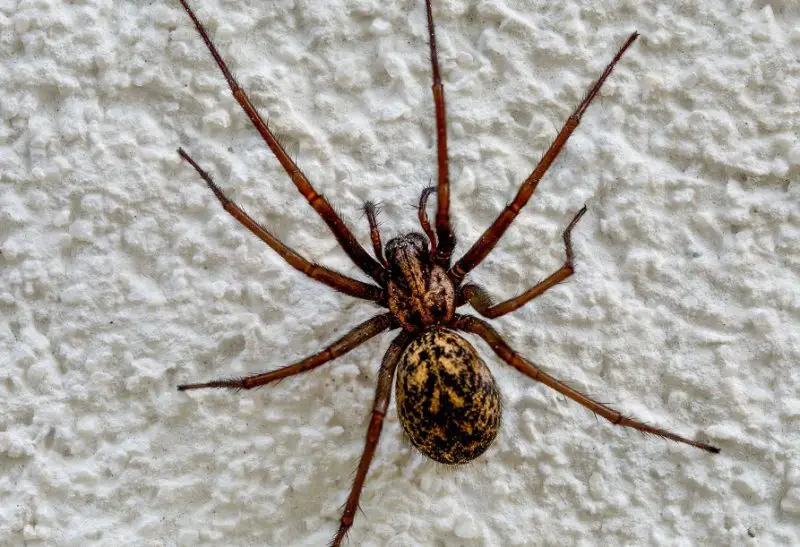
The Giant House Spider is among the largest spiders found in Montana homes. It has a leg span that can reach up to 4 inches, with a brown or gray body covered in darker mottling or chevron patterns on the abdomen. Its long, sturdy legs give it a commanding presence, especially when seen indoors.
This species builds large, flat sheet webs with a funnel-like retreat where the spider hides. It is mostly nocturnal, emerging at night to patrol its web or run across floors in search of mates. Despite its size and speed, Eratigena duellica is not aggressive and rarely bites.
In Montana, this spider is most commonly found in basements, garages, sheds, and crawl spaces. It prefers cooler, undisturbed environments and becomes more noticeable in autumn when males wander in search of females. Though often feared due to its size, it plays a helpful role in reducing insect populations indoors.
Black Lace-Weaver (Amaurobius ferox)
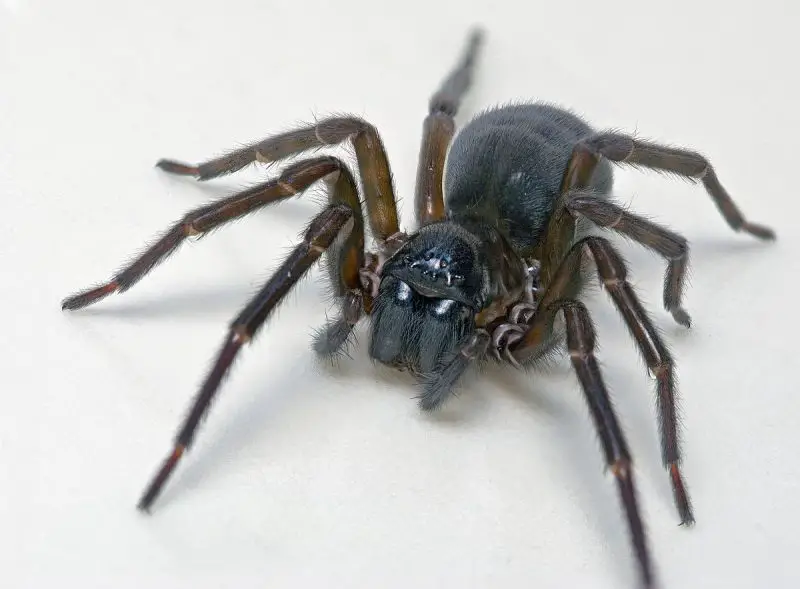
The Black Lace-Weaver (Amaurobius ferox) is a medium-sized spider recognized by its dark, reddish-brown body and velvety black abdomen marked with lighter chevrons. Its name refers to the intricate lace-like pattern of its cribellate silk, which gives its web a woolly texture. It has robust legs and a somewhat flattened appearance, typical of web-building spiders in its family.
This nocturnal species builds messy, lace-like webs in crevices, under bark, or around human structures such as sheds, woodpiles, and basement walls. Unlike orb-weavers, it relies on touch rather than sight to detect prey vibrations in its web. Females are known for guarding their egg sacs and caring for spiderlings until they disperse.
In Montana, Amaurobius ferox is frequently found around homes, especially in shaded, undisturbed areas. It is native to Europe but has become established in parts of North America, including the northern United States. Although it may appear threatening, this spider is not considered dangerous to humans.
Clubiona spp.
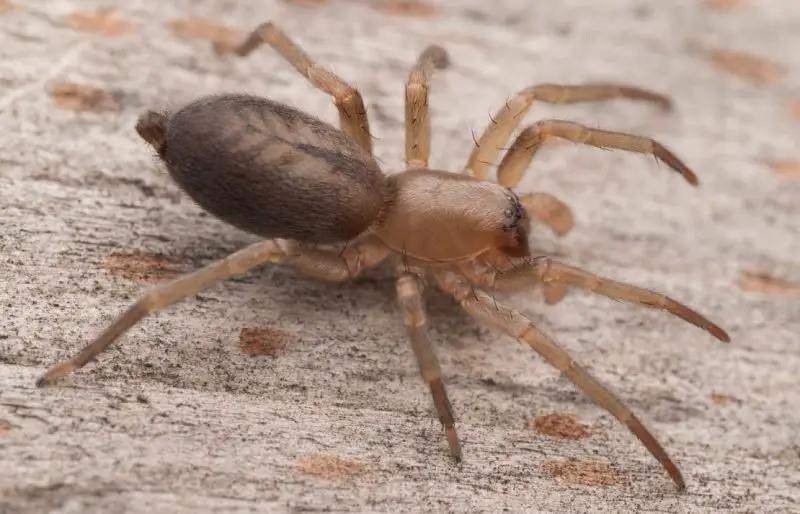
Spiders in the genus Clubiona, commonly called Sac Spiders or Leaf-curling Sac Spiders, are small to medium-sized hunters with slender, elongated bodies. Their coloration ranges from pale beige to reddish-brown, and they often have a smooth, glossy appearance with minimal markings. They are identifiable by their long spinnerets and relatively large jaws.
Clubiona species are active nocturnal predators that do not use webs to catch prey. Instead, they hide during the day in silken sacs under leaves, bark, or stones and emerge at night to hunt insects. Their sac-like retreats give them their common name and serve as shelters for molting and egg-laying.
These spiders are widespread in Montana, especially in grasslands, forests, and shrublands. They are often overlooked due to their small size and secretive behavior. Despite their biting potential, most species pose little threat to humans and contribute to natural insect control.
Sitticus fasciger (Asian Jumping Spider)
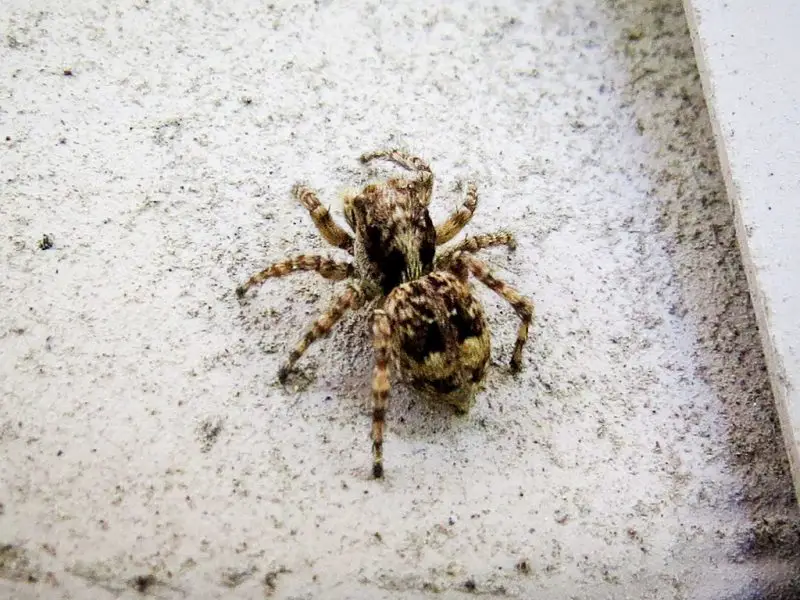
Sitticus fasciger, also known as the Asian Jumping Spider, is a small and curious species introduced to North America from Asia. It has a compact body and short legs, with a distinctive speckled gray-and-black appearance. Like all jumping spiders, it has large, forward-facing eyes that provide excellent vision for detecting prey and navigating its environment.
This species does not build webs for hunting but uses silk as draglines and to build protective shelters. It is an active daytime hunter, using short jumps to pounce on prey. Males perform courtship displays involving leg waving and body movements to attract females.
In Montana, Sitticus fasciger is typically found on tree trunks, fence posts, buildings, and other vertical surfaces. Though introduced, it appears to have adapted well to urban and natural habitats. Its small size and non-aggressive nature make it a harmless and often unnoticed resident of local ecosystems.
Dictyna spp.

Members of the genus Dictyna are small web-building spiders known for their tangled, cribellate silk webs. These spiders are typically grayish or brownish in color with a fuzzy appearance due to fine body hairs. They have a rounded abdomen often marked with pale stripes or mottled patterns, and relatively short legs.
Dictyna spiders build irregular webs over plant stems, twigs, and man-made structures, especially in dry and sunny habitats. Their cribellate silk lacks stickiness but effectively entangles small insects. These spiders sit near the center of their web, waiting for vibrations that signal prey activity.
In Montana, Dictyna species are common in fields, meadows, and along roadsides. Their small size and cryptic coloring make them difficult to spot unless their webs are carefully examined. While they are not harmful to humans, they play a role in controlling pest insect populations in natural and agricultural settings.
Tigrosa grandis

Tigrosa grandis is one of the larger wolf spiders native to North America and is particularly notable for its robust build and bold coloration. It has a dark brown to black body with prominent pale stripes running from the eyes down the cephalothorax and sometimes across the abdomen. Its large size and quick movements make it a striking sight when encountered.
Like other wolf spiders, Tigrosa grandis does not spin webs to catch prey but is an active ground hunter that relies on speed and strong vision. It roams primarily at night and can often be spotted by the reflective shine of its eyes when illuminated by a flashlight. Females carry egg sacs attached to their spinnerets and later carry spiderlings on their backs.
In Montana, this species inhabits grasslands, forest floors, and riverbanks. It prefers undisturbed areas with plenty of ground cover where it can hunt for beetles, crickets, and other arthropods. Though intimidating in appearance, Tigrosa grandis is not aggressive and will usually flee when disturbed.
Long-jawed Orb Weaver (Tetragnatha montana)
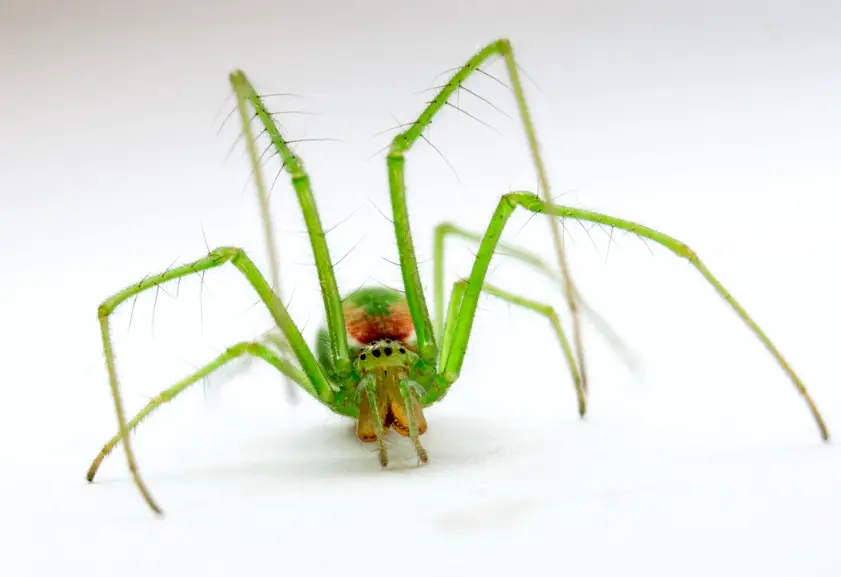
The Long-jawed Orb Weaver (Tetragnatha montana) is a slender spider distinguished by its elongated body and legs, with a pale greenish or yellowish coloration that provides excellent camouflage among foliage. Its most notable feature is its long chelicerae (jaws), which can extend well beyond the head, used in mating displays and prey capture.
This species builds horizontal orb webs close to water sources like ponds, streams, and wetlands. The webs are delicate yet efficient at catching small flying insects. During the day, these spiders often rest stretched out along grass stems or twigs, blending into their surroundings.
In Montana, Tetragnatha montana is commonly found near wetland areas and riparian zones, where humidity favors their survival. Their presence helps control populations of mosquitoes and other small insects, contributing to local ecological balance.
Neoscona oaxacensis (Western Spotted Orbweaver)
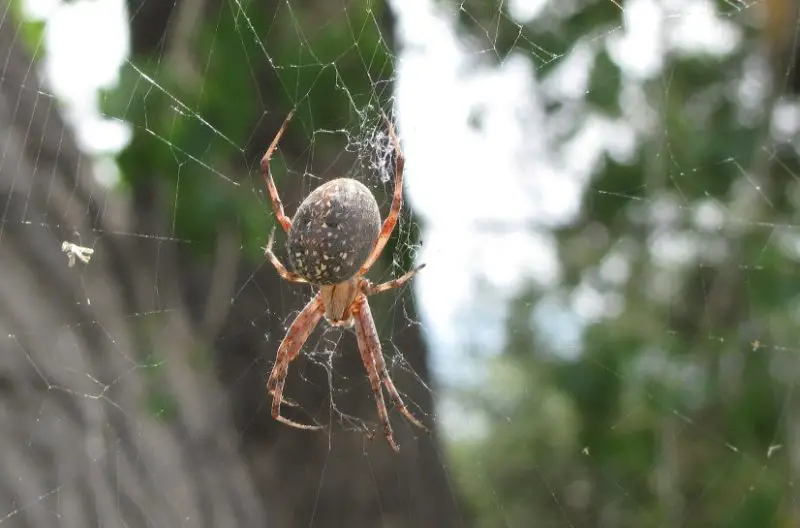
Neoscona oaxacensis, known as the Western Spotted Orbweaver, features a robust body with a distinctive pattern of white or cream spots on a brown or reddish abdomen. The cephalothorax is typically darker with lighter markings, and the legs are banded with alternating light and dark segments.
This orb-weaving spider constructs large, wheel-shaped webs, often in gardens, forests, and shrubs. The web is rebuilt frequently, usually at dusk, to ensure maximum prey capture efficiency. Neoscona oaxacensis is primarily nocturnal, hiding in a retreat during the day before emerging to hunt.
In Montana, this species thrives in varied habitats, from forest edges to urban parks. Its wide distribution and adaptable web-building behavior make it one of the more commonly observed orbweavers in the region, where it plays an important role in insect population control.
Woodlouse Spider (Dysdera crocata)
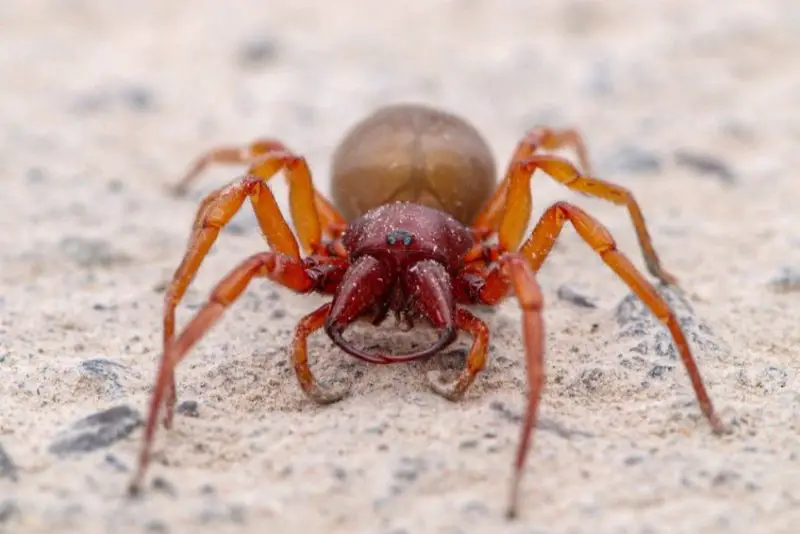
The Woodlouse Spider (Dysdera crocata) is a distinctive predator known for its reddish-orange cephalothorax and legs contrasted with a pale cream or yellowish abdomen. It has large, powerful chelicerae that are adapted for piercing the hard exoskeletons of woodlice, its primary prey.
Unlike many spiders, Dysdera crocata does not build webs to catch prey but actively hunts at night in leaf litter, under stones, or in other damp, sheltered places. Its slow but methodical stalking behavior allows it to effectively capture woodlice and other small invertebrates.
In Montana, this species is often found in gardens, basements, and woodpiles where woodlice populations are abundant. Although not native, it has established itself well and contributes to controlling woodlouse numbers. It is harmless to humans but can deliver a painful bite if handled carelessly.
Spitting Spider (Scytodes thoracica)

The Spitting Spider (Scytodes thoracica) is a small, pale yellowish spider with a distinctive domed cephalothorax and six eyes arranged in three pairs. Its name comes from its unique hunting method: it spits a sticky, venomous silk to immobilize prey before biting.
This spider prefers dark, sheltered environments such as caves, basements, and under bark. It hunts small arthropods by sneaking close and spitting the silk in rapid bursts to trap them, a technique that is unusual among spiders. After immobilizing the prey, it quickly delivers a venomous bite to subdue it.
In Montana, Scytodes thoracica is mainly found in human dwellings and other sheltered locations. Its reclusive behavior and small size make it rarely noticed, though it plays an important role in reducing insect pests indoors. It poses no significant risk to people.
Uloborus glomosus
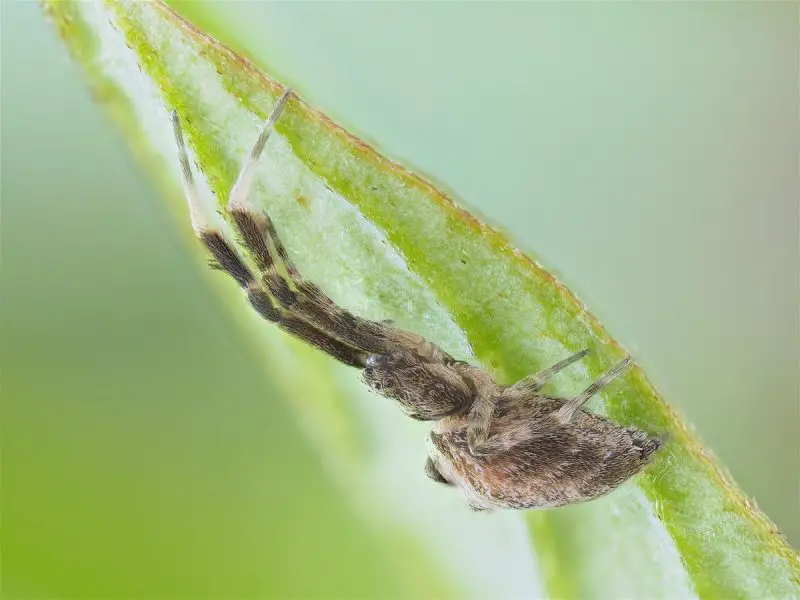
Uloborus glomosus is a cribellate orb-weaver spider characterized by its small size and delicate, fuzzy silk webs that lack sticky droplets. It has a light brown to tan body with subtle markings and relatively short legs compared to other orb weavers.
This species constructs horizontal orb webs in low vegetation, often near water or moist areas. Unlike most orb weavers, Uloborus glomosus does not produce venom; instead, it captures prey using its woolly cribellate silk, which entangles insects mechanically. It tends to stay near the center of its web, waiting patiently for prey to become trapped.
In Montana, this spider is found primarily in damp meadows, forest edges, and wetlands. Its unique silk and venomless nature make it an interesting example of spider diversity in the region’s ecosystems. Despite its small size, it contributes to controlling small insect populations effectively.
Oecobius navus (Tiny Wall Spider)

Oecobius navus, commonly called the Tiny Wall Spider, is a very small spider usually measuring only a few millimeters in length. It has a pale cream or light brown body with subtle darker markings, and its legs are relatively short and delicate. This species is easily recognized by its small size and the unique shape of its web.
This spider builds small, dome-shaped webs often found in cracks, corners, and crevices on walls or rocks. Unlike typical orb-weavers, its webs are flat and closely attached to surfaces, serving as both a retreat and a prey-catching tool. It is a nocturnal hunter, preying mainly on tiny insects and other arthropods.
In Montana, Oecobius navus is commonly found in urban areas and sometimes in natural rocky habitats. It prefers sheltered, dry locations such as under bark or inside buildings. Despite its small size, it contributes to controlling pest insects and is harmless to humans.
Southern Black Widow (Latrodectus mactans)
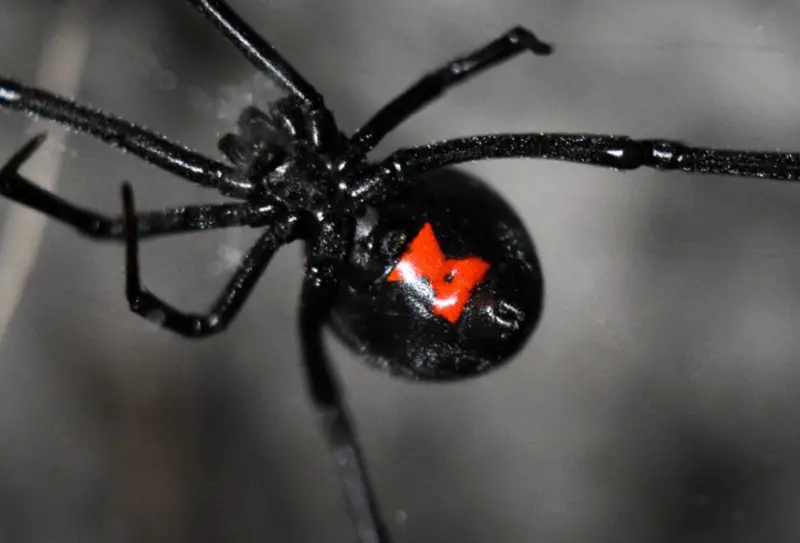
The Southern Black Widow (Latrodectus mactans) is a well-known venomous spider famous for its glossy black body and striking red hourglass marking on the underside of its abdomen. Females are larger and more robust than males and can measure up to 15 mm in body length.
This spider typically builds irregular, tangled webs in dark, sheltered locations such as woodpiles, sheds, and under rocks. It is a nocturnal hunter, using its strong web to trap flying or crawling insects. While its venom is potent, bites are rare and usually only serious if untreated.
In Montana, the Southern Black Widow is less common but has been reported in warmer, sheltered areas, particularly in the southern parts of the state. Awareness of its presence is important, though encounters with humans are infrequent due to its shy nature.
Western Black Widow (Latrodectus hesperus)

The Western Black Widow (Latrodectus hesperus) closely resembles its southern cousin, with a shiny black body and a red hourglass on the abdomen’s underside. It is slightly larger on average and known for its potent neurotoxic venom. Females are much larger than males and possess the characteristic bulbous abdomen.
This species prefers dry, sheltered habitats like garages, crawl spaces, woodpiles, and rocky crevices. Its web is irregular and strong, capable of trapping large prey. The Western Black Widow is primarily nocturnal and avoids human contact but can bite defensively when threatened.
In Montana, Latrodectus hesperus is more widespread than the Southern Black Widow, inhabiting arid and semi-arid environments across the state. While bites can be medically significant, fatalities are extremely rare with proper medical care.
Titiotus spp.

Spiders in the genus Titiotus are medium-sized wandering spiders with a robust build and muted brown or gray coloration, often with subtle patterning that provides camouflage in leaf litter or on tree bark. They have strong legs adapted for quick running and hunting.
Unlike web-building spiders, Titiotus species actively hunt prey on the ground or on vegetation. They are nocturnal and seek shelter during the day under rocks, logs, or bark. Their behavior is generally secretive, and they are rarely observed except by careful searching.
In Montana, Titiotus species are found mostly in forested areas and mountainous terrain. Their role as nocturnal predators helps control populations of insects and other arthropods, contributing to the balance of local ecosystems.
Tegenaria domestica (Domestic House Spider)

The Domestic House Spider (Tegenaria domestica) is a common, medium-sized spider with a brown or tan body marked by various stripes or chevrons on the abdomen. It has long, spindly legs and is often mistaken for the Giant House Spider (Eratigena duellica), though T. domestica is generally smaller.
This species builds large, messy sheet webs in corners of homes, garages, and other buildings. It tends to remain in its web, waiting to ambush insects that become trapped. It is mostly nocturnal and can be found throughout the year in human structures.
In Montana, Tegenaria domestica is widespread in urban and suburban areas, thriving in sheltered indoor spaces. It poses no danger to humans and helps reduce populations of household pest insects.




